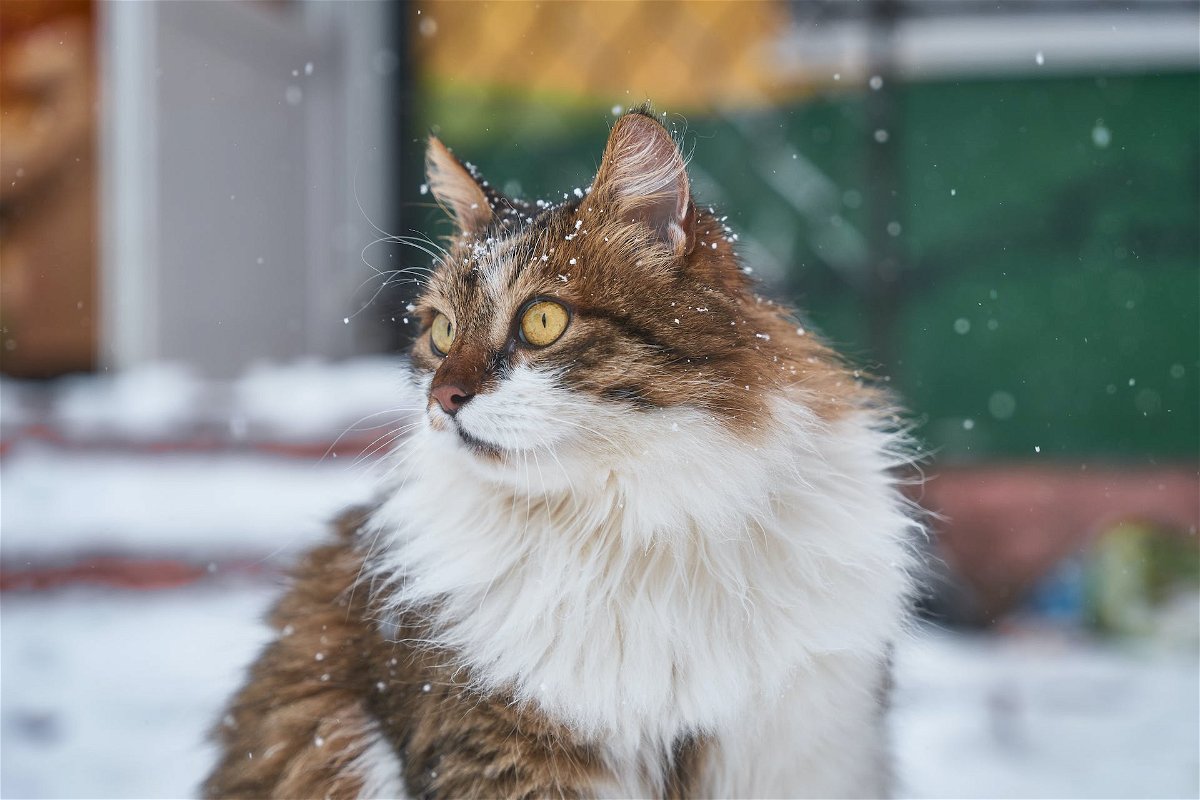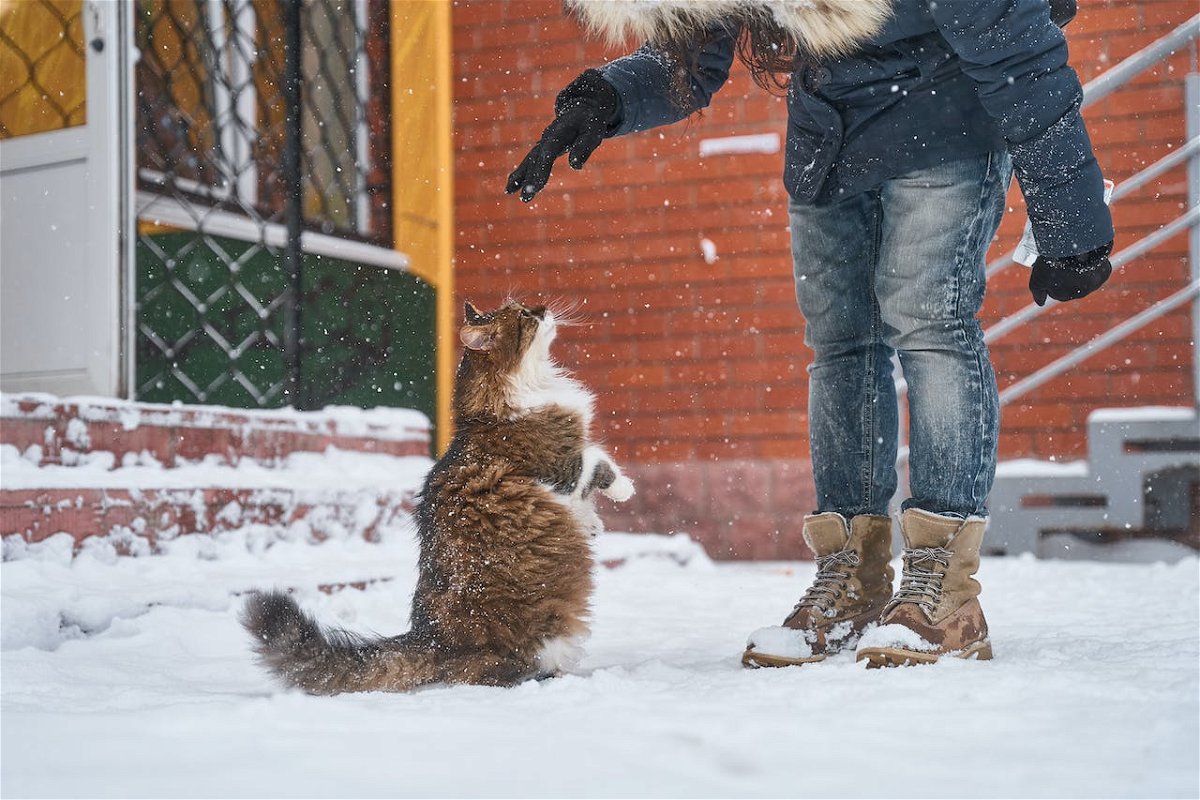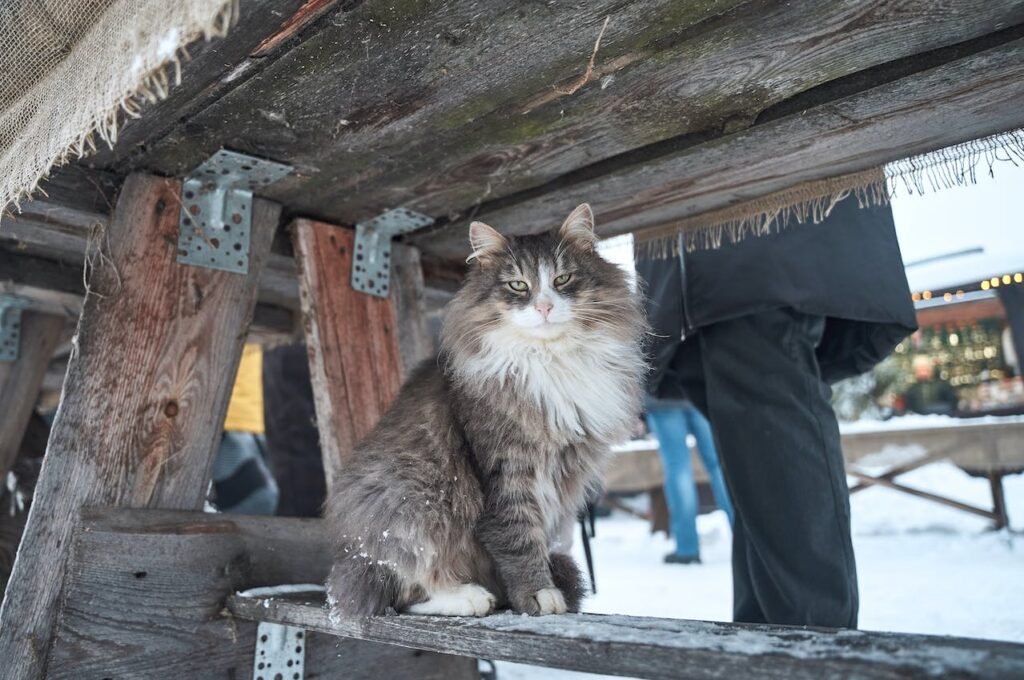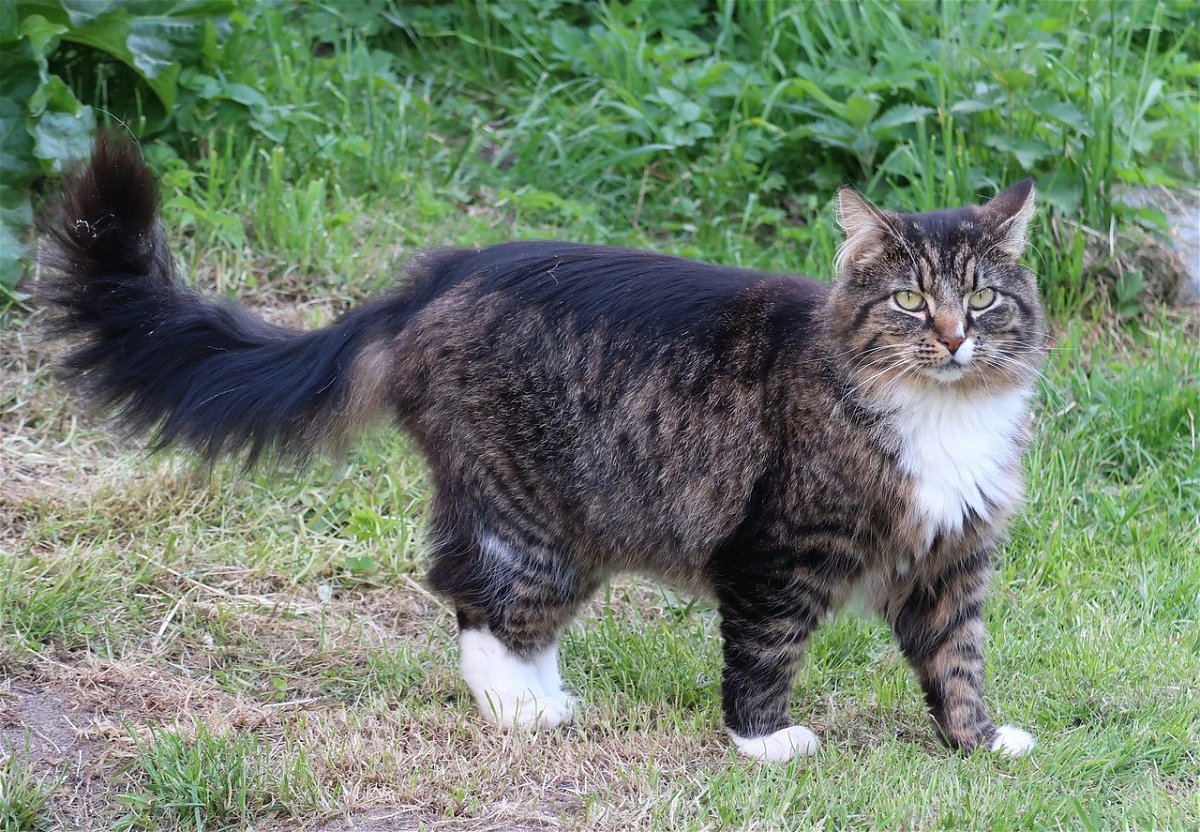We're an affiliate
We hope you love the products we recommend! Just so you know, we may collect a share of sales or other compensation from the links on this page at no additional cost to you. Thank you if you use our links, we really appreciate it!
The Norwegian Forest Cats, often called ‘Wegies,’ are majestic and robust cat breed that originated in the forests of Norway.
Known for their striking appearance, friendly demeanor, and thick, luxurious coats, these cats have captivated the hearts of many cat lovers.
The breed’s coat helped their ancestors survive the chilly weather in the forests of Norway. Modern-day Wegies are lovely housecats, famed for their temperament and sheer beauty.
In this comprehensive guide, we’ll delve into everything you need to know about the Norwegian Forest Cat breed including their history, care, and many more.
Norwegian Forest Cat Overview
| Official name | Norwegian Forest Cat |
| Other names | Wegie, skogkatt |
| Origin | Norway |
| Size | Large |
| Length | 36 inches |
| Weight | Up to 18 pounds |
| Coat | Long hair, dense undercoat |
| Shedding | Medium to frequent |
| Colors | White, Black, Ebony, Blue, Red, Tan, Lavender, Cream, Silver, Golden, Orange, Cameo, Tortoiseshell, Brown |
| Eye color | Gold, blue, gold-green, copper, odd eyed. |
| Lifespan | 12-16 years |
| Grooming needs | Regular brushing |
| Social needs | High |
| Energy level | Active |
| Vocal level | Low |
| Temperament | Bold, gentle, friendly, and adaptable |
| Exercise Needs | Moderate |
Norwegian Forest Cat Breed History
As the name suggests, the Norwegian Forest Cat originates from Norway. It is said that the history of these felines can go back to the times of the Vikings.
There’s evidence of images and illustrations of Norwegian Forest cats existing from as early as the 16th century.
In the popular Norse myth, this breed’s ancestors, who were large and powerful, are believed to have pulled the golden chariots of the goddess Freya across the skies.
During the early years of the 20th century, the Norwegian Forest Cats nearly became instinct because of poor cross breeding practices with other breeds.

Cat enthusiast in Norway were alarmed by this trend and it took them several years of careful breeding to restore their forest cat numbers.
In 1938, the Wegies were declared the official national cat breed by Norway’s King Olav V, a move which cemented the breed’s identity.
The first Norwegian Forest Cats were brought into the United States in 1979. Five years later in 1984, they were recognized as a breed by the International Cat Association.
Norwegian Forest Cat Appearance
The appearance of the Norwegian Forest Cat cannot be described in one sentence. But if we were to do so, we’d definitely say it’s a gorgeous cat with an eye-catching appearance.
They have large bodies, with well-balanced solid muscles supported by strong bone structures. Wegies have broad chests and considerable thickness, although they don’t always appear to be fat.
You’ll notice that the breed’s back legs are slightly longer than their front limbs, making their rump somewhat longer than their shoulders.
Wegies have medium to large heavily furred ears which are slightly wide at the base and rounded at the tip.
The most striking feature of the Norwegian Forest Cats has to be their specialized double coat which helped to keep them warm in the Scandinavian unforgiving weather.

The breed’s standard highlights this water-resistant outer coat should form a ruff at the chest, and it should be pronounced in the neck region.
This breed has a long bushy tail which should ideally be the same length as the cat’s body. You’ll also notice the britches on the breed’s hind limbs and heavy tufting between the toes.
Although most Wegies are white, they also come in different colors and patterns except those that point to hybridization such as chocolate and lilac.
Norwegian Forest Cat Care
Owning this breed comes with great responsibilities. Norwegian Forest Cats need weekly brushing to keep their dense coat in top condition.
Gliding through their coat using a soft-bristle brush will prevent the hair from matting and help untangle the tiny knots.
When brushing your forest cat, you need to pay special attention to the underarms, tail, tummy, and other areas where the fur may rub and tangle more easily.
The brushing movement should be delicate and gentle, especially when working around the chest and belly, to avoid potential injuries.
You can expect heavy shedding during seasonal changes, so you need to brush your kitty more frequently to keep the loose fur at bay before they ingest some and develop hairballs.
On top of regular brushing, it is prudent to bathe your Norwegian Forest Cat once in every few months. Washing your cat with warm water and cat shampoo will reduce dandruff and eliminate fleas.
Plan on regular trims to keep your cat’s nails short and neat. Overgrown nails can cause pain in the paw pads, causing difficulty in movement.
Trimming your cat’s nails is also a great way of protecting your furniture and other valuables from unnecessary scratches.
Inspect your cat’s ears regularly for dirt, debris, redness, or bad smell. You’ll need some cotton balls and a high-quality ear-cleaning solution to wipe through your Wegie’s ears.
Don’t use Q-tips to clean the ears because it has the risk of hurting the eardrums or causing damage to the ear canals.
You’ll need to brush your cat’s teeth regularly using vet-approved toothpaste and a soft toothbrush to keep their whites in top condition and for fresh breath.
There are lots of cat toys in the market specially designed to wipe off food debris and prevent teeth irritation.
Remember to start grooming your cat from a tender age during their kittenhood years, so that they start accepting these activities early.
Consistent grooming will also improve your cat’s blood circulation and help keep unpleasant infections and allergies at bay.
Norwegian Forest Cat Temperament
Don’t let the ‘forest cat’ tag in the name of Wegies trick you into thinking otherwise about these beauties from Norway.
On the contrary, Wegies are people-loving but they won’t solicit your attention excessively unless they want something urgently.
Norwegian Forest Cats have a stable temperament that makes them a great choice for families with children and other pets. Make sure to teach your children how to handle cats with respect.

Despite the breed’s rugged exteriors and muscular appearance, Wegies have a sweet disposition that makes them form strong bonds with their lovely families.
The other top highlight of Wegies is their low vocal nature. These felines from Norway prefer to use body language in communication, and will only speak up when something is wrong.
Wegies are highly intelligent meaning they can do well in basic training, just make sure to use clickers to capture their attention.
You can keep their smart personality active by providing puzzle toys and teaching them new tricks and commands to keep them occupied.
Norwegian Forest Cat Diet and Nutrition
Norwegian Forest Cats should be given a well-balanced diet at least twice a day while strictly observing portion control.
Wegies are large cats, so they should never eat too much because they can easily add extra pounds with an ounce more of food.
Too much weight can predispose your Wegie to certain chronic illnesses including heart diseases, hypertension, diabetes mellitus, arthritis, and cancer.
To ensure monitored feeding, you should not leave open food for your cat to freely indulge. This practice can cause your Wegie to ingest more than they need, causing more harm than good.
High-quality cat food with enough proteins, minerals, vitamins, and fiber will nourish your Wegies and help prevent most health problems thereby increasing their lifespan.
You can try cat foods formulated for Maine Coons because the two breeds have a lot of similarities in nutrition requirements.
Remember to keep your cat hydrated throughout the day by providing access to clean drinking water. You can motivate them to take in more water by using a water fountain instead of a bowl.
If you feel like your cat is not getting enough water, you can increase their intake by providing them with high-moisture foods.
We recommended seeking the advice of a vet nutritionist or a regulated breeder about the best diet and food types to give your Wegie based on assessed circumstances.
Norwegian Forest Cat Health
Just like all breeds, the Norwegian Forest Cat is predisposed to certain health conditions that a reputable breeder should alert you on before purchase.
Wegies are prone to hypertrophic cardiomyopathy (HCM), a chronic illness that causes thickening (hypertrophy) of the heart muscles. An echocardiogram can be used to ascertain if your cat has HCM.
They are also predisposed to hip dysplasia, which can be attributed to their large size and muscular structure.
Hip dysplasia is a hereditary condition characterized by loosening of the hip sockets. This illness can range from mild to severe, and affected cats are less likely to jump.
Wegies can also get Glycogen storage disease type IV (GSD IV), which causes a deficiency in the enzyme required for the metabolism of glycogen into glucose.
This rare condition leads to muscle atrophy and organ dysfunction, and it can cause fatalities when severe.
Before picking up your Norwegian Forest Cat from a breeder, ask them to provide you with all the health clearance certificates outlined in the breed standards.
Walk away from any breeder who doesn’t work within the regulations, codes, and ethics of cat breeding programs in your country.
Norwegian Forest Cat Exercise and Play Needs
Wegies are best suited in environments where they get immense opportunities to play, hunt, and explore.
It’s best to give your cat a convenient outdoor space where they can exercise their natural instincts to jump, hunt, and play.
Forest cats are excellent climbers, so make sure they have enough window perches, shelves, and cat trees to exercise.

You can enrich the exercise needs of your Norwegian feline by providing enough puzzle toys for mental stimulation and reward.
Have enough interactive cat toys to keep your Wegie occupied positively. Remember to rotate and refresh their toys to provide more exciting fun, prevent boredom, and satisfy their curious nature.
5 Facts about Norwegian Forest Cats
1. Norwegian Forest Cats are shrouded in Myths
Wegies are not your ordinary housecat with a clear history, they are an active character in long-held myths and legends.
One of the most fascinating folklore is their connection with Norse, where the breed’s ancestors were believed to pull the golden chariots of goddess Freyja across the skies in her daily rounds.
2. Norwegian Forest Cats mature slowly
Unlike most other cat breeds, Norwegian Forest Cats are slow to mature. These elegant felines can reach their full physical growth and emotional development at around 5 years.
3. Norwegian Forest Cats are excellent climbers
In their native land of Norway, Norwegian Forest Cats are known as Norsk Skogkatt, which translates to “forest cat.”
Wegies are renowned for their impressive climbing skills, especially in the mountainous regions. They often scale sheer cliff faces with ease, showcasing their incredible agility and adaptability.
4. They’re the National Cats of Norway
The Norwegian Forest Cats were officially crowned the national cat of Norway by King Olaf V in 1938. Norway is among the few countries with an official national animal.
5. They have built-in winter coats
The Norwegian Forest Cats can withstand the harshest winter in Scandinavian countries, thanks to their in-built water-resistant coats.
In addition to the long double-layered coat, Wegies also have tufted ears and toes which work like little boots and earmuffs for extra protection against harsh weather.
Conclusion
The Norwegian Forest Cat bred stands out as a charming blend of beauty, intelligence, and play-centric pet.
From their mythical origins to their impressive size and water-resistant coat, this breed has secured a special place in the hearts of many pet parents.
Despite being lovely house pets, Wegies are not lap cats meaning they can thrive without soliciting your attention, but they equally don’t like to be left alone for a long time.
This breed needs measured amounts of food to prevent them from being overweight and weekly brushing to keep their coat in top condition.
You Might Also Like: Sphynx Cat Breed Review
Laura is the founder of Furs'n'Paws. She is a also a pet writer and expert with more than 20 years of experience of working with dogs and cats. She developed a very strong love for animals at a young age. Her passion led her to establish a thriving pet sitting and dog walking business in Dubai. As an expert in pet training, behavior, and nutrition, Laura is committed to helping pet owners and pet lovers by offering high-quality information on a wide range of topics.



No responses yet